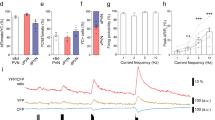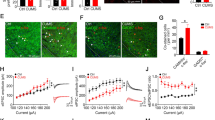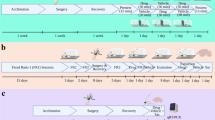Abstract
In the cerebellum, there are numerous cholecystokinin (CCK-8)-containing fibers. Since systemic CCK-8 injection-induced anxiety (psychological stress) activates the locus coeruleus cells that send mossy fiber inputs to the cerebellum, we examined whether systemic CCK-8 injections activate the rat and mouse cerebellum. First, injections of CCK-8 were found to induce c-fos mRNA expression in a vague patchy pattern that is different from single methamphetamine-induced Zebrin band-like c-fos mRNA expression, suggesting that the CCK-8 activating mossy fibers induce gene expression differently from the dopamine-containing mossy fibers in the ventral tegmental area. Second, since CCK-8 facilitates neural activity of dopamine in the midbrain, we examined whether repeated methamphetamine administration that induced behavioral sensitization had similar effects on the cerebellar CCK system. Repeated administration of methamphetamine suppressed the CCK-8-induced c-fos mRNA expression in the rat cerebellum. Third, capsaicin injections (physical stress) into a hind limb of the rat increased junD mRNA expression with no effect on c-fos mRNA expression, and repeated methamphetamine injections had no effect on the capsaicin-induced expression of junD mRNA. Fourth, either single injection of methamphetamine or CCK-8 to mice increased c-fos mRNA expression in the locus coeruleus, and so noradrenalin, but not dopamine, might interact with CCK-8-activating system. However, we considered the possibility unlikely. Thus, we conclude that repeated methamphetamine administration though dopamine selectively inhibits the c-fos mRNA expression after CCK-8 injection in the cerebellum.




Similar content being viewed by others
References
Barik S, de Beaurepaire R (2005) Dopamine D3 modulation of locomotor activity and sleep in the nucleus accumbens and in lobules 9 and 10 of the cerebellum in the rat. Prog Neuropsychopharmacol Biol Psychiatry 29(5):718–726
Barthel F, Loeffler JP (1995) Beta 2-adrenoreceptors stimulate c-fos transcription through multiple cyclic AMP- and Ca(2+)-responsive elements in cerebellar granular neurons. J Neurochem 64(1):41–51
Beinfeld MC (2001) An introduction to neuronal cholecystokinin. Peptides 22(8):1197–1200
Beinfeld MC, Connolly K, Pierce RC (2001) OLETF (Otsuka Long-Evans Tokushima Fatty) rats that lack the CCK 1 (A) receptor develop less behavioral sensitization to repeated cocaine treatment than wild type LETO (Long Evans Tokushima Otsuka) rats. Peptides 22(8):1285–1290
Beinfeld MC, Connolly KJ, Pierce RC (2002) Cocaine treatment increases extracellular cholecystokinin (CCK) in the nucleus accumbens shell of awake, freely moving rats, an effect that is enhanced in rats that are behaviorally sensitized to cocaine. J Neurochem 81(5):1021–1027
Caterina MJ, Schumacher MA, Tominaga M, Rosen TA, Levine JD, Julius D (1997) The capsaicin receptor: a heat-activated ion channel in the pain pathway. Nature 389(6653):816–824
Chrapusta SJ, Egan MF, Masserano JM, Wyatt RJ (1994) Dopamine release in the rat cerebellum and hippocampus: a tissue 3-methoxytyramine study. Brain Res 655(1–2):271–275
Crawley JN (1991) Cholecystokinin-dopamine interactions. Trends Pharmacol Sci 12(6):232–236
DeSousa NJ, Wunderlich GR, De Cabo C, Vaccarino FJ (1999) The expression of behavioral sensitization to amphetamine: role of CCK(A) receptors. Pharmacol Biochem Behav 62(1):31–37
Dietrichs E (1988) Cerebellar cortical and nuclear afferents from the feline locus coeruleus complex. Neuroscience 27(1):77–91
Ding WQ, Larsson C, Alling C (1998) Stimulation of muscarinic receptors induces expression of individual fos and jun genes through different transduction pathways. J Neurochem 70(4):1722–1729
Eccles JL, Ito M, Senthagothai J (1967) The cerebellum as a neuronal machine. Springer, Berlin
Facchinetti P, Rose C, Rostaing PH, Rostaing PH, Triller A, Schwartz JC (1998) Immunolocalization of tripeptidyl peptidase II, a cholecystokinin-inactivating enzyme, in rat brain. Neuroscience 88(4):1225–1240
Ferrucci M, Busceti CL, Nori SL, Lazzeri G, Bovolin P, Falleni A, Mastroiacovo F, Pompili E, Fumagalli L, Paparelli A, Fornai F (2007) Methamphetamine induces ectopic expression of tyrosine hydroxylase and increases noradrenalin levels within the cerebelllar cortex. Neuroscience 149:871–884
Fleckenstein AE, Gibb JW, Hanson GR (2000) Differential effects of stimulants on monoaminergic transporters: pharmacological consequences and implications for neurotoxicity. Eur J Pharmocol 406:1–13
Franklin TR, Druhan JP (2000) Expression of Fos-related antigens in the nucleus accumbens and associated regions following exposure to a cocaine-paired environment. Eur J Neurosci 12(6):2097–2106
Freeman AS, Chiodo LA, Lentz SI, Wade K, Bannon MJ (1991) Release of cholecystokinin from rat midbrain slices and modulatory effect of D2 DA receptor stimulation. Brain Res 555(2):281–287
Graybiel AM, Moratalla R, Robertson HA (1990) Amphetamine and cocaine induce drug-specific activation of the c-fos gene in striosome-matrix compartments and limbic subdivisions of the striatum. Proc Natl Acad Sci USA 87(17):6912–6916
Gubler U, Chua AO, Young D, Fan ZW, Eng J (1987) Cholecystokinin mRNA in porcine cerebellum. J Biol Chem 262(31):15242–15245
Hamamura M, Leng G, Emson PC, Kiyama H (1991) Electrical activation and c-fos mRNA expression in rat neurosecretory neurones after systemic administration of cholecystokinin. J Physiol (Lond) 444:51–63
Hamamura M, Ozawa H, Kimuro Y, Okouchi J, Higasa K, Iwaki A, Fukumaki Y (1999) Differential decreases in c-fos and aldolase C mRNA expression in the rat cerebellum after repeated administration of methamphetamine. Mol Brain Res 64(1):119–131
Hamamura M, Hirata N, Sawada K, Shuto T, Shimazoe T, Terada Y, Fukumaki Y (2008) Reversal of the expression pattern of Aldolase C mRNA in Purkinje cells and Ube 1x mRNA in Golgi cells by a dopamine D1 receptor agonist injections in the methamphetamine sensitized-rat cerebellum. J Neural Transmission 115(7):959–971. doi:10.1007/s00702-008-0032-9
Hayashida T, Eversole-Cire P, Jones PA, Sasaki H (1997) Imprinted genes are up-regulated by growth arrest in embryonic fibroblasts. J Biochem (Tokyo) 122(5):901–903
Hokfelt T, Skirboll L, Rehfeld JF, Goldstein M, Markey K, Dann O (1980) A subpopulation of mesencephalic dopamine neurons projecting to limbic areas contains a cholecystokinin-like peptide: evidence from immunohistochemistry combined with retrograde tracing. Neuroscience 5(12):2093–2124
Hokfelt T, Skirboll L, Everitt B, Meister B, Brownstein M, Jacobs T, Faden A, Kuga S, Goldstein M, Markstein R (1985) Distribution of cholecystokinin-like immunoreactivity in the nervous system. Co-existence with classical neurotransmitters and other neuropeptides. Ann N Y Acad Sci 448:255–274
Honkaniemi J, Kainu T, Ceccatelli S, Rechardt L, Hokfelt T, Pelto-Huikko M (1992) Fos and jun in rat central amygdaloid nucleus and paraventricular nucleus after stress. Neuroreport 3(10):849–852
Huang Q, Zhou D, Chase K, Gusella JF, Aronin N, DiFiglia M (1992) Immunohistochemical localization of the D1 dopamine receptor in rat brain reveals its axonal transport, pre- and postsynaptic localization, and prevalence in the basal ganglia, limbic system, and thalamic reticular nucleus. Proc Natl Acad Sci USA 89(24):11988–11992
Hurd YL, Herkenham M (1992) Influence of a single injection of cocaine, amphetamine or GBR 12909 on mRNA expression of striatal neuropeptides. Mol Brain Res 16(1–2):97–104
Iadarola MJ, Berman KF, Zeffiro TA, Byas-Smith MG, Gracely RH, Max MB, Bennett GJ (1998) Neural activation during acute capsaicin-evoked pain and allodynia assessed with PET. Brain 121(Pt 5):931–947
Ikai Y, Takada M, Shinonaga Y, Mizuno N (1992) Dopaminergic and non-dopaminergic neurons in the ventral tegmental area of the rat project, respectively, to the cerebellar cortex and deep cerebellar nuclei. Neuroscience 51(3):719–728
Jagerschmidt A, Popovici T, O’Donohue M, Roques BP (1994) Identification and characterization of various cholecystokinin B receptor mRNA forms in rat brain tissue and partial determination of the cholecystokinin B receptor gene structure. J Neurochem 63(4):1199–1206
Kalivas PW, Duffy P (1991) A comparison of axonal and somatodendritic dopamine release using in vivo dialysis. J Neurochem 56(3):961–967
Kalivas PW, Stewart J (1991) Dopamine transmission in the initiation and expression of drug- and stress-induced sensitization of motor activity. Brain Res Brain Res Rev 16(3):223–244
Kalivas PW, Weber B (1988) Amphetamine injection into the ventral mesencephalon sensitizes rats to peripheral amphetamine and cocaine. J Pharmacol Exp Therapeut 245(3):1095–1102
Khan ZU, Mrzljak L, Gutierrez A, de la Calle A, Goldman-Rakic PS (1998) Prominence of the dopamine D2 short isoform in dopaminergic pathways. Proc Natl Acad Sci USA 95(13):7731–7736
King JS, Bishop GA (1990) Distribution and brainstem origin of cholecystokinin-like immunoreactivity in the opossum cerebellum. J Comp Neurol 298(3):373–384
Kizer JS, Palkovits M, Brownstein MJ (1976) The projections of the A8, A9 and A10 dopaminergic cell bodies: evidence for a nigral-hypothalamic-median eminence dopaminergic pathway. Brain Res 108(2):363–370
Lidwell K, Griffiths R (2000) Possible role for the FosB/JunD AP-1 transcription factor complex in glutamate-mediated excitotoxicity in cultured cerebellar granule cells. J Neurosci Res 62(3):427–439
Madtes PC Jr, King JS (1994) Distribution of cholecystokinin binding sites in the North American opossum cerebellum. J Chem Neuroanat 7(1–2):105–112
Maharajan P, Maharajan V, Ravagnan G, Paino G (2001) The weaver mutant mouse: a model to study the ontogeny of dopamine transmission systems and their role in drug addiction. Prog Neurobiol 64(3):269–276
Marley PD, Rehfeld JF (1984) Extraction techniques for gastrins and cholecystokinins in the rat central nervous system. J Neurochem 42(6):1515–1522
Melchitzky DS, Lewis DA (2000) Tyrosine hydroxylase- and dopamine transporter-immunoreactive axons in the primate cerebellum. Neruropsychopharmacology 22(5):466–472
Mercer LD, Beart PM, Horne MK, Finkelstein DI, Carrive P, Paxinos G (1996) On the distribution of cholecystokinin B receptors in monkey brain. Brain Res 730(2):313–318
Monnikes H, Lauer G, Bauer C, Tebbe J, Zittel TT, Arnold R (1997) Pathways of Fos expression in locus coeruleus, dorsal vagal complex, and PVN in response to intestinal lipid. Am J Physiol 273(6 Pt 2):R2059–R2071
Pierce RC, Kalivas PW (1997) Repeated cocaine modifies the mechanism by which amphetamine releases dopamine. J Neurosci 17(9):3254–3261
Poncelet M, Arnone M, Heaulme M, Gonalons N, Gueudet C, Santucci V, Thurneyssen O, Keane P, Gully D, Le Fur G (1993) Neurobehavioural effects of SR 27897, a selective cholecystokinin type A (CCK-A) receptor antagonist. Naunyn Schmiedebergs Arch Pharmacol 348(1):102–107
Rehfeld JF, Mogensen NW, Bardram L, Hilsted L, Monstein HJ (1992) Expression, but failing maturation of procholecystokinin in cerebellum. Brain Res 576(1):111–119
Robinson TE, Becker JB (1986) Enduring changes in brain and behavior produced by chronic amphetamine administration: a review and evaluation of animal models of amphetamine psychosis. Brain Res 396(2):157–198
Robinson TE, Jurson PA, Bennett JA, Bentgen KM (1988) Persistent sensitization of dopamine neurotransmission in ventral striatum (nucleus accumbens) produced by prior experience with (+)-amphetamine: a microdialysis study in freely moving rats. Brain Res 462(2):211–222
Sasamura T, Sasaki M, Tohda C, Kuraishi Y (1998) Existence of capsaicin-sensitive glutamatergic terminals in rat hypothalamus. Neuroreport 9(9):2045–2048
Schreihofer DA, Cameron JL, Verbalis JG, Rinaman L (1997) Cholecystokinin induces Fos expression in catecholaminergic neurons of the macaque monkey caudal medulla. Brain Res 770:37–44
Segal DS, Weinberger SB, Cahill J, McCunney SJ (1980) Multiple daily amphetamine administration: behavioral and neurochemical alterations. Science 207(4433):905–907
Shilling PD, Feifel D, Kelsoe JR (2000) Amphetamine-induced zif208 mRNA expression in the medial posterior nucleus accumbens in cholecystokinin-A receptor mutant rats. Neurosci Lett 281(1):17–20
Shuto T, Kuroiwa M, Hamamura M, Yabuuchi K, Shimazoe T, Watanabe S, Nishi A, Yamamoto T (2006) Reversal of methamphetamine-induced behavioral sensitization by repeated administration of a dopamine D1 receptor agonist. Neuropharmacology 50(8):766–991
Studler JM, Reibaud M, Herve D, Blanc G, Glowinski J, Tassin JP (1986) Opposite effects of sulfated cholecystokinin on DA-sensitive adenylate cyclase in two areas of the rat nucleus accumbens. Eur J Pharmacol 126:125–128
Vaccarino FJ (1994) Nucleus accumbens dopamine-CCK interactions in psychostimulant reward and related behaviors. Neurosci Biobehav Rev 18(2):207–214
Van Kampen J, Frydryszak H, Stoessl AJ (1996) Behavioural evidence for cholecystokinin-dopamine D1 receptor interactions in the rat. Eur J Pharmacol 298(1):7–15
Wood PL (1989) CCK modulation of cerebellar afferents: dopaminergic involvement. Prog Neuropsychopharmacol Biol Psychiatry 13(3–4):513–518
Wood PL, Steel DJ, Kim HS, Petrack B, Altar CA (1988) Inhibition of climbing and mossy fiber input to mouse cerebellar Purkinje cells by cholecystokinin. J Pharmacol Exp Therapeut 244(1):6–58
Wunderlich GR, DeSousa NJ, Vaccarino FJ (2000) Cholecystokinin modulates both the development and the expression of behavioral sensitization to amphetamine in the rat. Psychopharmacology 151(2–3):283–290
Wunderlich GR, Rotzinger S, Bush DE, DeSousa NJ, Vaccarino FJ (2004) Cholecystokinin modulation of locomotor behavior in rats is sensitized by chronic amphetamine and chronic restraint stress exposure. Brain Res 1001(1–2):95–107
Yamashita A, Hayashi M, Shimizu K, Oshima K (1990) Neuropeptide-immunoreactive cells and fibers in the developing primate cerebellum. Brain Res Develop Brain Res 51(1):19–25
Yang G, Zhang Y, Ross ME, Iadecola C (2003) Attenuation of activity-induced increases in cerebellar blood flow in mice lacking neuronal nitric oxide synthase. Am J Physiol 285(1):H298–H304
Zanoveli JM, Netto CF, Guimaraes FS, Zangrossi H Jr (2004) Systemic and intra-dorsal Periaqueductal gray injections of cholecystokinin sulfated octapeptide (CCK-8 s) induce a panic-like response in rats submitted to the elevated T-maze. Peptides 25:1935–1941
Author information
Authors and Affiliations
Corresponding author
Rights and permissions
About this article
Cite this article
Hamamura, M., Ozawa, H., Ozaki, M. et al. Repeated administration of methamphetamine blocked cholecystokinin-octapeptide injection-induced c-fos mRNA expression without change in capsaicin-induced junD mRNA expression in rat cerebellum. J Neural Transm 117, 1041–1053 (2010). https://doi.org/10.1007/s00702-010-0444-1
Received:
Accepted:
Published:
Issue Date:
DOI: https://doi.org/10.1007/s00702-010-0444-1




